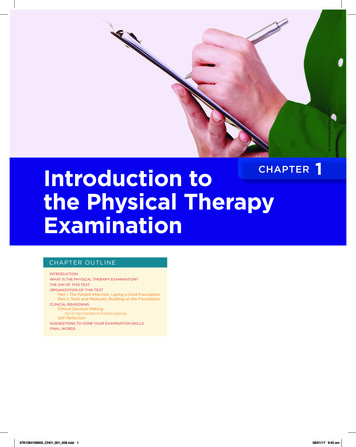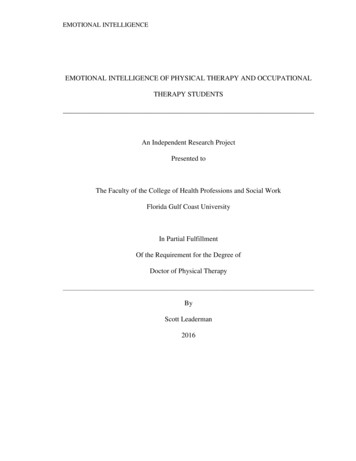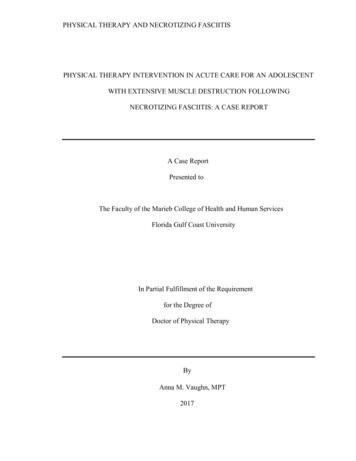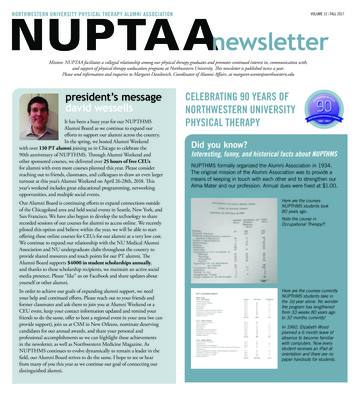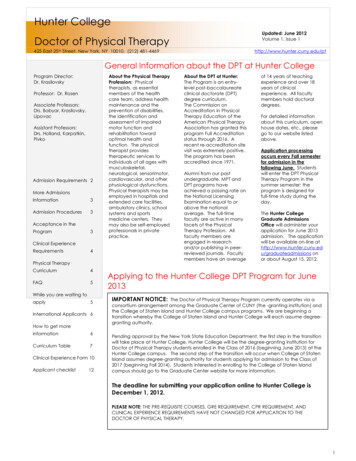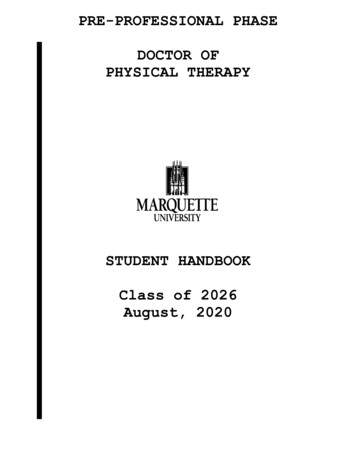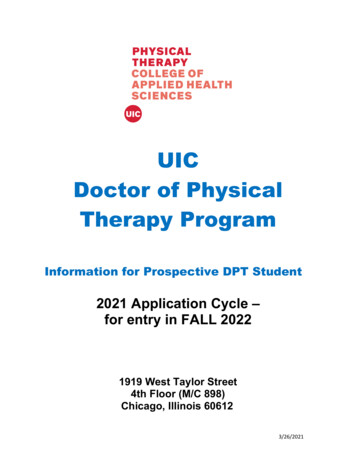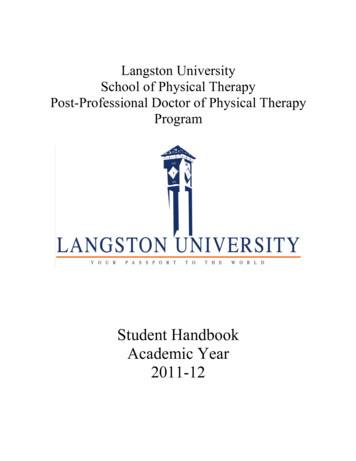
Transcription
Physical Therapy ToolkitTreatment Guides - Section 1InterventionsBalanceFall Risk Assessment and PreventionFunctional MobilityGaitTherapeutic ExerciseConditions and DiseasesAdhesive CapsulitisAlzheimer’s Disease and Related Dementias - Mid StageAlzheimer’s Disease and Related Dementias - Late StageAmputation of the Lower LimbAmyotrophic Lateral SclerosisAnkle SprainAnkylosing SpondylitisBiceps TendinitisBreast Cancer - Pre and Postoperative ManagementBurn InjuryCancerCardiac DiseaseCardiac SurgeryCarpal Tunnel Syndrome - Conservative ManagementCarpal Tunnel Syndrome - Postoperative ManagementCervical Stenosis, Myelopathy, and RadiculopathyCervical Spine SurgeryChronic Obstructive Pulmonary DiseaseChronic/Persistent Pain SyndromeComplex Regional Pain Syndrome Type ICongestive Heart Failure (see Cardiac Disease)Cubital Tunnel Syndrome - Conservative ManagementCubital Tunnel Syndrome - Postoperative ManagementDe Quervain's Syndrome - Conservative ManagementDe Quervain's Syndrome - Postoperative ManagementDiabetes - TypeDizzinessEmphysema (see Chronic Obstructive Pulmonary Disease)Epicondylitis - Conservative ManagementFracture of the Ankle (Lateral/Medial/Posterior Malleolus)Fracture of the Elbow (Radial Head/Olecranon/Distal Humerus)Fracture of the Hip (Proximal Femur)Fracture of the Knee (Tibial Plateau/Patella)Fracture of the Shoulder (Proximal Humerus)Fracture of the Wrist (Distal Radius) 2018 Cheryl Hall www.pttoolkit.com
Physical Therapy ToolkitTreatment Guides - Section 1Conditions and DiseasesFrailty and DebilityGreater Trochanteric Pain SyndromeGuillain-Barré SyndromeHuntington's DiseaseJoint ContracturesKidney DiseaseLow Back Pain - AcuteLow Back Pain - Chronic (see Chronic/Persistent Pain Syndrome)Low Back Pain - Sacroiliac JointLumbar StenosisLumbar Spine SurgeryMorbid Obesity - Person of SizeMultiple SclerosisMyasthenia Gravis - GeneralizedMyocardial InfarctionOsteoarthritis - Conservative ManagementOsteoporosisPalliative Care and HospiceParkinson's Disease - Early StageParkinson's Disease - Mid StageParkinson's Disease - Late StagePeripheral NeuropathyPeripheral Vascular DiseasePiriformis SyndromePlantar FasciitisPost-Poliomyelitis SyndromePressure UlcersRheumatoid Arthritis - Conservative ManagementRotator Cuff Pathology - Conservative ManagementRotator Cuff Pathology - Postoperative ManagementScleroderma/Systemic SclerosisSpinal Cord Injury - Paraplegia T1-S5Spinal Cord Injury - Tetraplegia/Quadriplegia C1-8StrokeTotal Ankle Replacement (Arthroplasty)Total Hip Replacement (Arthroplasty)Total Knee Replacement (Arthroplasty)Total Shoulder Replacement (Arthroplasty)Urinary IncontinenceVertebral Compression Fracture 2018 Cheryl Hall www.pttoolkit.com
Physical Therapy ToolkitFunctional Mobility - Section 2Adaptive EquipmentAdaptive Equipment for BathingAdaptive Equipment for MobilityAdaptive Equipment for Moving in BedAdaptive Equipment for TransfersAdaptive Equipment for Using the BathroomAdaptive Equipment for WalkingAmbulationWalk with a Cane on the Stronger, Left SideWalk with a Cane on the Stronger, Right SideWalk with a Standard Walker - Full Weight BearingWalk with a Standard Walker - Non-Weight BearingWalk with a Standard Walker - Partial Weight BearingWalk with a Standard Walker - Toe-Touch Weight BearingWalk with a Standard Walker - Weight Bearing as ToleratedWalk with a Wheeled Walker - Full Weight BearingWalk with a Wheeled Walker - Weight Bearing as ToleratedBath TransfersTransfer to Shower Chair (back up, turn left)Transfer to Shower Chair (back up, turn right)Transfer to Shower Chair (left leg, right leg, sit)Transfer to Shower Chair (right leg, left leg, sit)Transfer to Shower Chair (left leg, sit, right leg)Transfer to Shower Chair (right leg, sit, left leg)Transfer to Tub Bench - After Hip Surgery (back up, turn left)Transfer to Tub Bench - After Hip Surgery (back up, turn right)Transfer to Tub Bench (back up, turn left)Transfer to Tub Bench (back up, turn right)Transfer Wheelchair to Tub Bench - Move to the LeftTransfer Wheelchair to Tub Bench - Move to the RightBed MobilityBridgingIn and Out of Bed - Toward Your Left SideIn and Out of Bed - Toward Your Left Side After Hip SurgeryIn and Out of Bed - Toward Your Left Side Log RollingIn and Out of Bed - Toward Your Right SideIn and Out of Bed - Toward Your Right Side After Hip SurgeryIn and Out of Bed - Toward Your Right Side Log RollingIn and Out of Bed - Toward Your Weaker Left SideIn and Out of Bed - Toward Your Weaker Right SideIn and Out of Bed with Help - Toward Their Left SideIn and Out of Bed with Help - Toward Their Right Side 2018 Cheryl Hall www.pttoolkit.com
Physical Therapy ToolkitFunctional Mobility - Section 2Bed MobilityMove From One Side of the Bed to the OtherMove Up in BedRoll onto Your Left SideRoll onto Your Right SideStairsDown a Curb or Single Step Using a WalkerDown Steps with a Rail Using a CaneDown Steps with a Rail Using a Closed WalkerDown Steps with a Rail Using an Open WalkerDown Steps without a Rail Using a CaneUp a Curb or Single Step Using a WalkerUp Steps with a Rail Using a CaneUp Steps with a Rail Using a Closed WalkerUp Steps with a Rail Using an Open WalkerUp Steps without a Rail Using a CaneTransfersCar TransferGet Down On the FloorGet Up From the FloorSit-Pivot Transfer - Move to the LeftSit-Pivot Transfer - Move to the RightSit-Pivot Transfer with Help - Move to Their LeftSit-Pivot Transfer with Help - Move to Their RightSitting DownSitting Down - After Hip SurgeryStanding UpStanding Up - After Hip SurgeryStanding Up with HelpStand-Pivot Transfer with Help - Move to Their LeftStand-Pivot Transfer with Help - Move to Their RightTransfer Board - Move to the LeftTransfer Board - Move to the RightWheelchair MobilityWheelchair Mobility 2018 Cheryl Hall www.pttoolkit.com
Physical Therapy ToolkitEducational Handouts - Section 3Amputation of the Lower LimbCare of the Prosthesis and Lower Limb CoveringsCare of Your Residual LimbPhantom Limb PainPosition Your Residual Limb - AKAPosition Your Residual Limb - BKACardiopulmonaryBreathing Distress - Causes and Tips to PreventBreathing Distress ControlCardiac Precautions for Exercise - Therapist ResourceControlled CoughDaily Tasks after Open Heart SurgeryDeep (Diaphragmatic) BreathingHow to Check Your Heart RatePostural Drainage - Chest PercussionPostural Drainage PositionsPursed Lip BreathingSternal (Breastbone) PrecautionsTips to Conserve EnergyOtherArm MeasurementCheck Your SkinLeg MeasurementPain JournalPosition in Bed to Reduce PressurePressure ReliefStress ManagementStress Management - Relaxation ToolsTips to Prevent Lower Body LymphedemaTips to Prevent Upper Body LymphedemaNeurologicalCognitive Strategies to Improve MovementPosition in Bed - Left Side WeaknessPosition in Bed - Right Side WeaknessPosition Your Arm - Left Side WeaknessPosition Your Arm - Right Side WeaknessProtect the Arm - Left Side WeaknessProtect the Arm - Right Side WeaknessOrthopedicBody MechanicsDaily Tasks after Back (Lumbar) SurgeryDaily Tasks after Neck (Cervical) Surgery 2018 Cheryl Hall www.pttoolkit.com
Physical Therapy ToolkitEducational Handouts - Section 3OrthopedicDaily Tasks after Shoulder SurgeryDesensitizationEdema (Swelling) Control of the Arm(s)Edema (Swelling) Control of the Leg(s)Good PostureHip Dislocation Precautions - Posterior ApproachJoint Protection and Energy Conservation for Wheelchair UsersScar MassageSelf Traction (Unloading)Spinal Surgery PrecautionsSplint/Brace InstructionsSuperficial ColdSuperficial HeatSafetyDon’t Let a Fall Get You Down - BookletDon’t Let a Fall Get You Down Post - Fall SurveyFall Triggers and Tips to Prevent Falls - Therapist ResourceFoot Care and Foot SafetyHome Safety Assessment - Therapist ResourceUsing a Front Wheel Walker (2 wheels)Using a Rollator (3 or 4 wheels)Using a Standard Walker (no wheels)Using a Wheelchair 2018 Cheryl Hall www.pttoolkit.com
Physical Therapy ToolkitTherapeutic Exercise Handouts - Section 4Back/Core ExercisesCore Exercise GuidelinesCore Exercises - Back MusclesCore Exercises - Pelvic MusclesCore Exercises - Stomach MusclesExercise Ball GuidelinesExercise Ball - Back MusclesExercise Ball - Pelvic MusclesExercise Ball - Stomach MusclesLow Back StretchesTrunk Active Range of MotionBalance ExercisesBalance Exercise GuidelinesBalance Exercises - SittingBalance Exercises - StandingCondition Specific Exercise ProgramsAbove Knee Amputation ExercisesBelow Knee Amputation ExercisesBurn Injury StretchesFemur Fracture ExercisesGreater Trochanteric Pain Syndrome ExercisesHip Replacement ExercisesKnee Replacement ExercisesLumbar Stenosis ExercisesLumbar Surgery ExercisesMastectomy ExercisesOsteoporosis Extension ExercisesParkinson’s Disease ExercisesPiriformis Syndrome ExercisesPlantar Fasciitis ExercisesPulmonary ExercisesTibial Plateau Fracture ExercisesExercise GuidelinesExercise Tips for Amyotrophic Lateral SclerosisExercise Tips for Ankylosing SpondylitisExercise Tips for ArthritisExercise Tips for DiabetesExercise Tips for Guillain-Barré SyndromeExercise Tips for Multiple SclerosisExercise Tips for Myasthenia GravisExercise Tips for Orthopedic ConditionsExercise Tips for Post-Poliomyelitis Syndrome 2018 Cheryl Hall www.pttoolkit.com
Physical Therapy ToolkitTherapeutic Exercise Handouts - Section 4Exercise GuidelinesExercise Tips for Renal ConditionsLower Extremity ExercisesAnkle and Foot Active Range of MotionAnkle and Foot Isometric ExercisesAnkle and Foot Strength ExercisesAnkle and Foot StretchesCalf StretchesHip and Knee Exercises - LyingHip and Knee Exercises - SeatedHip and Knee Exercises - StandingHip StretchesStretch Band Exercises - LegsThigh StretchesNeck ExercisesNeck Active Range of MotionNeck Isometric ExercisesNeck Strength ExercisesNeck StretchesOther ExercisesArm CycleCool-Down StretchesExercise LogGeneral Exercise TipsPassive Range of MotionPassive Range of Motion - Left Side WeaknessPassive Range of Motion - Right Side WeaknessPelvic Floor (Kegel) ExercisePhysical Activity PlanTotal Body Exercise ProgramWalking GuidelinesWarm-Up ExercisesPre-Gait ExercisesPre-Gait Exercise TipsPre-Gait Arm Strength ExercisesPre-Gait Hip and Knee Strength ExercisesPre-Gait Mat/Bed ExercisesPre-Gait Standing ExercisesUpper Extremity ExercisesArm Strength ExercisesDowel Exercises - SupineDowel Exercises - Upright 2018 Cheryl Hall www.pttoolkit.com
Physical Therapy ToolkitTherapeutic Exercise Handouts - Section 4Upper Extremity ExercisesElbow, Forearm and Wrist Active Range of MotionElbow, Forearm and Wrist Strength ExercisesElbow, Forearm and Wrist StretchesElbow, Wrist and Hand Active ExercisesFinger and Thumb Strength Exercises - LeftFinger and Thumb Strength Exercises - RightFinger and Thumb Stretches and Active Range of Motion - LeftFinger and Thumb Stretches and Active Range of Motion - RightFlexor Tendon GlidesForearm and Wrist Active Range of MotionForearm and Wrist Strength ExercisesForearm and Wrist StretchesMedian Nerve GlidesNerve Flossing - MedianNerve Flossing - RadialNerve Flossing - UlnarPendulum Exercises - LeftPendulum Exercises - RightPosture ExercisesPutty ExercisesScapular Mobility and Strength Exercises - Left Side WeaknessScapular Mobility and Strength Exercises - Right Side WeaknessShoulder Active Range of MotionShoulder and Hand Active ExercisesShoulder and Rotator Cuff Active Exercises - LeftShoulder and Rotator Cuff Active Exercises - RightShoulder and Rotator Cuff Exercises Free Weight - LeftShoulder and Rotator Cuff Exercises Free Weight - RightShoulder and Rotator Cuff Exercises Stretch Band - LeftShoulder and Rotator Cuff Exercises Stretch Band - RightShoulder Blade ExercisesShoulder, Elbow, and Hand Active ExercisesShoulder Isometric Left - SeatedShoulder Isometric Left - StandingShoulder Isometric Right - SeatedShoulder Isometric Right - StandingShoulder Passive and Active-Assisted Range of Motion - LeftShoulder Passive and Active-Assisted Range of Motion - RightShoulder Pulley ExercisesShoulder StretchesStretch Band Exercises - Arms 2018 Cheryl Hall www.pttoolkit.com
Physical Therapy ToolkitBalanceImpairments and Functional Limitations:Muscle weakness (specifically quadriceps, ankle dorsiflexors, ankle plantar flexors)Limited range of motion in the lower extremitiesSlowed reaction timeReduced processing of sensory information (proprioceptive/somatosensory, visual andvestibular)DisequilibriumCognitive impairmentAssessments and Rating Scales:Berg Balance Scale (Berg 1995)Gait Speed Test (Guralnik et al., 1994)Modified Clinical Test of Sensory Integration on Balance (Shumway-Cook 1986)Multi-Directional Reach Test (Newton et al., 1997)Sitting Balance Scale (Medley, Thompson et al., 2011)Tinetti Balance and Gait Evaluation (Tinetti 1986)Trunk Impairment Scale (Verheyden et al., 2004)Physical Therapy Intervention:Provide a multi-component balance training program. Ensure patient safety during training to prevent falls and injuries. Incorporate balance exercises into everyday activities. Incorporate balance exercises during regular strength training, stretching, andendurance routines. Perform balance training first (when combined with resistance and flexibilityactivities). Recommend 10-15 minutes, three days a week.Provide progressive challenges to balance. Static balance control in sitting, half kneeling, tall kneeling, standing, tandemstanding, single leg standing, lunging and squatting Dynamic balance control while on a moving surface (therapy ball, wobble board,mini trampoline) Challenge postural reactionso Ankle strategyo Hip strategyo Stepping strategyo Weight shift strategyo Suspension strategy 2018 Cheryl Hall www.pttoolkit.com
Physical Therapy ToolkitBalancePhysical Therapy Intervention:Progress balance activities and exercises by challenging the visual system (low lighting,wear sunglasses indoors, eyes closed), the proprioceptive/somatosensory system(unstable surfaces such as foam pads, therapy ball, mini trampoline, balance disc,wob
Physical Therapy Toolkit Treatment Guides - Section 1 Interventions Balance Fall Risk Assessment and Prevention Functional Mobility Gait Therapeutic Exercise Conditions and Diseases Adhesive Capsulitis Alzheimer’s Disease and Related Dementias - Mid Stage

